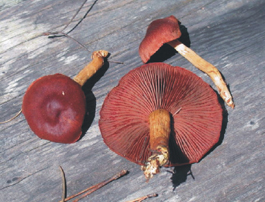home | north bay bohemian index | sonoma, napa, marin county restaurants | arcadia

Photograph by Darvin DeShazer
Silk Soaker Dermocybe phoenicea var. occidentalis leaches red.
Fungal Bloom
Mushrooms! Man, I see colors!
By P. Joseph Potocki
We buy, hunt, cultivate, cook and eat mushrooms. They can be a gastronomic pleasure, a mind-expanding experience or a game of Russian roulette leading to illness and even death. But few ever equate mushrooms with paper, ink, crayons and rainbow-colored clothing dyes.
Forty years ago, while a youthful generation of Americans rejected consumer plasticity by emigrating "back to the land," then-50-year-old Mendocino artist Miriam C. Rice was already there. Rice quietly worked with wood blocks and batik. She also taught youngsters at the Mendocino Art Center how to concoct and use natural dyes.
One day, friends asked Rice to join them on a mushroom hunt. Once home, she tossed a clump of gathered sulfur-yellow, gilled-cap mushrooms into a dye pot along with some wool yarn. The mushroom's reproductive apparatus leached out its color, gifting the wool a bright, lemon yellow. To Rice's knowledge, this had never been done before.
And so began decades of experiments, discoveries and inventions, as well as a tiny organic revolution, spreading from the cool, wet coastal woods of Mendocino and Sonoma counties to Scandinavia, Scotland and Australia. In 1973, Thresh Publications in Santa Rosa, a small press specializing in craft arts, asked Miriam Rice to write about her mushroom color discoveries vis-à-vis dye-making concoctions. The result was a little book entitled Let's Try Mushrooms for Color. It featured pen and ink drawings by Forestville freelance scientific illustrator Dorothy Beebee, herself a longtime practitioner of natural dye applications and spinning.
"I was working with Thresh Publications," Beebee says. "They asked me to read this manuscript, and I was entranced with it." The publishers drove her up to Mendocino to meet Miriam Rice. So began a close collaboration lasting to this very day. "Miriam celebrated her 90th birthday just this last January. It was wonderful." To commemorate the event, Beebee says, "we had an international symposium on mushroom dyes."
Just as Let's Try Mushrooms for Color was going to press, Rice discovered a "mysterious" stand of mushrooms under Bishop pines in Mendocino County. These fungi yielded brilliant purple, rose and burgundy hues, leading Rice to expand her research and document results of new experimentations in the book Mushrooms for Color, published by Eureka's Mad River Press in 1980.
As her work progressed, Rice realized that the thorny issue of mordants had to be addressed. Mordants are metallic salts used to set dye to fiber. The mordants traditionally used for this purpose are toxic. These include tin, chrome and copper. So Rice replaced them with iron and alum. Her successful move from harmful mordants has led Rice to gently urge others to achieve bright, vibrant colors sans toxins, too.
Which is not to say all mushrooms used to dye fabric are nontoxic. In fact, one of the draws for using fungi as color dyes is that those species best suited to these purposes tend either to be unpalatable, inedible or flat-out poisonous. Consequently, there's little or no competition with foragers seeking edible mushrooms. Furthermore, Beebee assures that these poisonous varietals pose no threat imparting mephitic payloads to one wearing said clothing, though persons with specific allergies or medical conditions might well be wary.
Back when Rice had just started down her mushroom-strewn path, she was already devoted to recycling within her realm. This led to a second field of inquiry and an entirely new mycological application.
Say your fabric gets dyed and is drying. Now, what to do with waste materials from the spent dye?
Rice's solution was to convert fungi detritus into richly textured artisan paper. Polypores, or shelf mushrooms (like artist's conk, turkey tails and red-belted conk), are particularly amenable to papermaking. But Rice saw yet another application spinning out of her mushroom dye-making processes—namely ink, which then led to the trademark protected crayon-like process called Myco-Stix.
Miriam C. Rice and Dorothy Beebee have recently published yet another book, titled Mushrooms for Dyes, Paper, Pigments and Myco-Stix. It's billed by Beebee as the compendium of everything Miriam Rice has accomplished inside mushroom's magic kingdom, which is to say a brilliant, colorful and abundant lot.
To learn more on mushroom dyes et al., go to the Sonoma County Mycological Association website, www.somamushrooms.org. To learn more about 'Mushrooms for Dyes,' go to www.mushroomsforcolor.com.
Send a letter to the editor about this story.
|
|
|
|
|
|